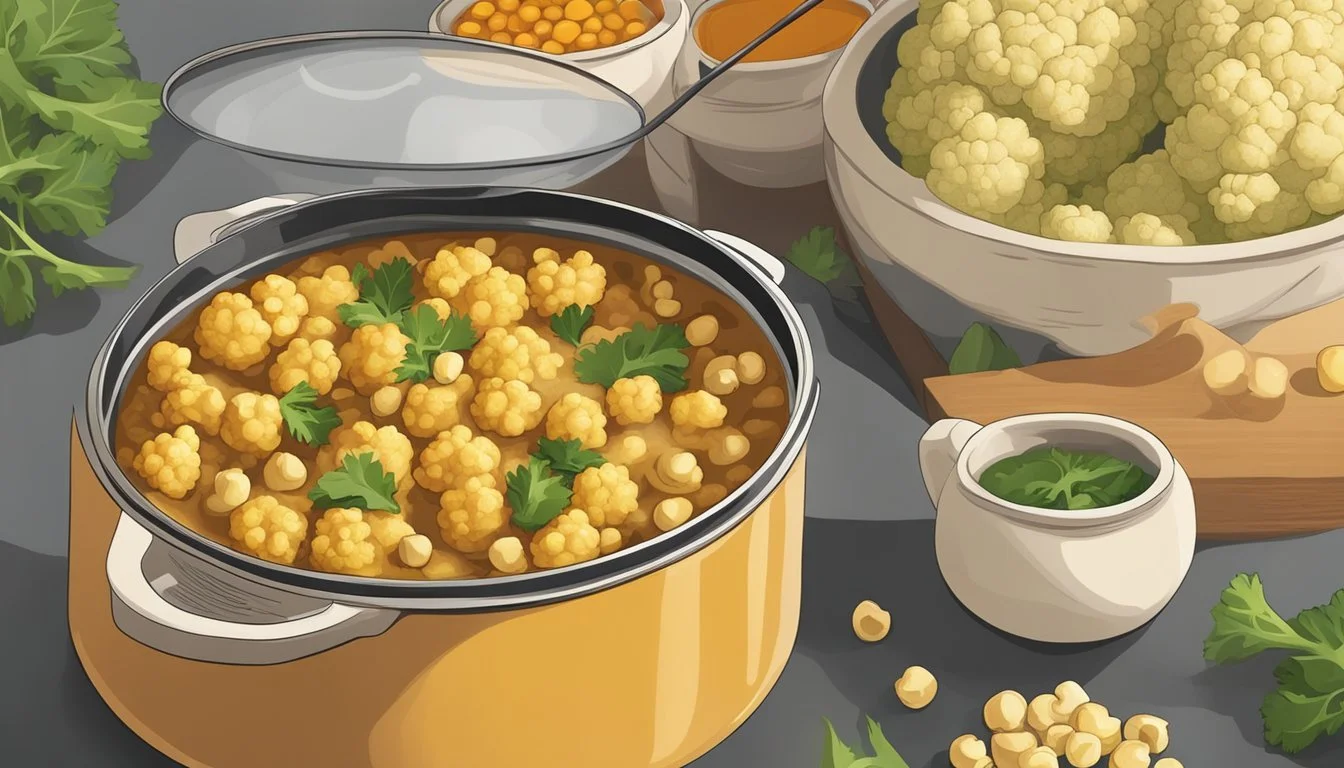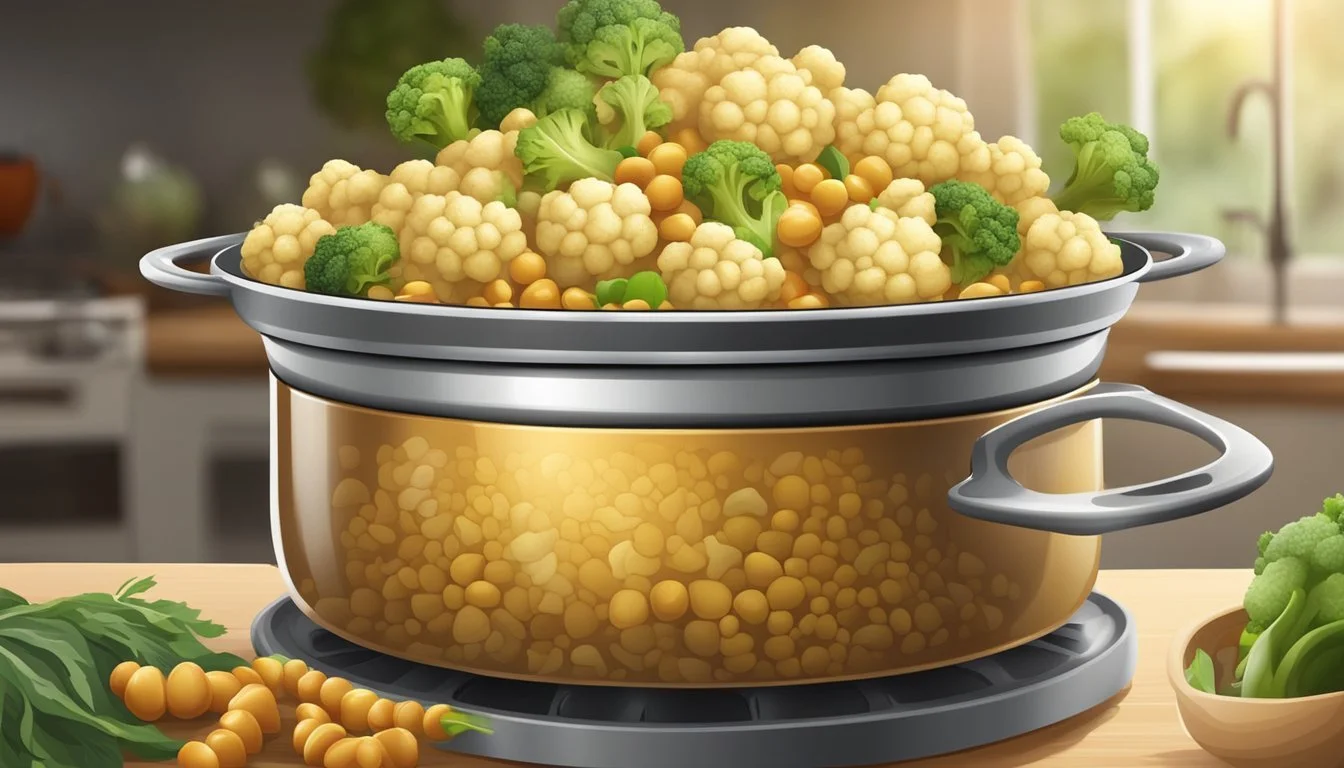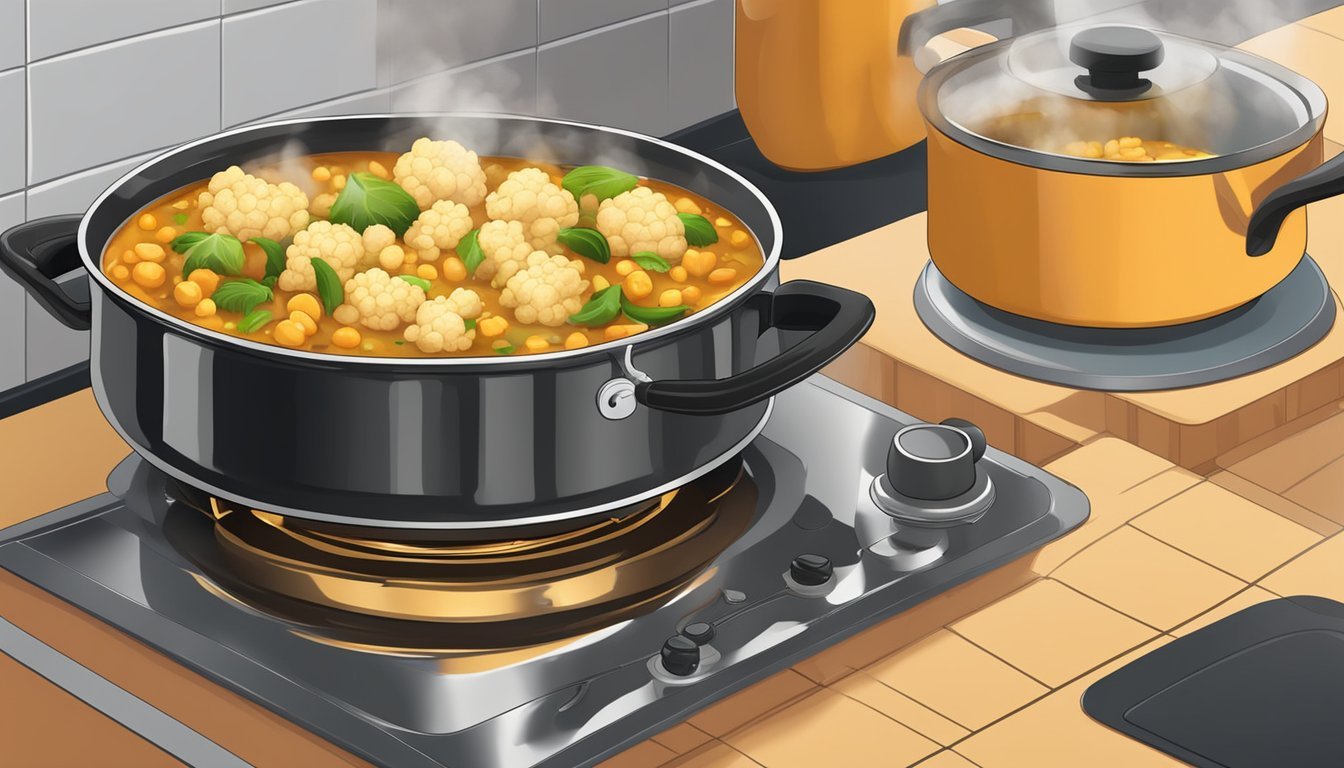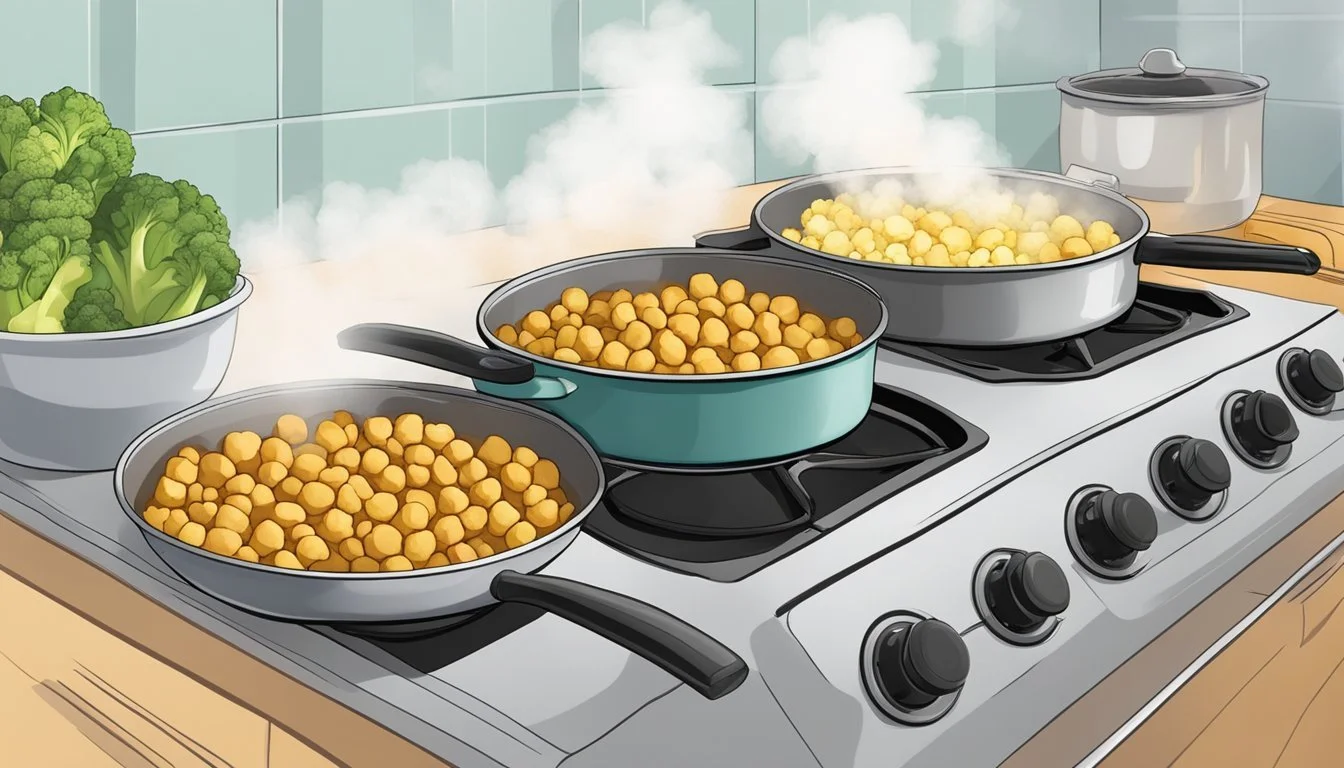Best Way to Reheat Cauliflower and Chickpea Curry While Preserving Vegetable Tenderness
When it comes to reheating cauliflower and chickpea curry, the goal is to warm the dish throughout without compromising the tender texture of the vegetables. Cauliflower, in particular, is prone to becoming too soft or mushy if not reheated with care. The chickpeas should also retain their shape and texture, adding a satisfying bite to the dish. The best methods to reheat the curry involve gentle and even heat application that gradually raises the temperature of the meal.
Oven reheating is a recommended method as it provides a controlled environment where the curry can be brought back to temperature evenly. A preheated oven at a moderate temperature, such as 350°F (180°C), is suitable for warming the curry without drying it out. Adding a bit of water or stock can help maintain the moisture content of the sauce. Covering the dish with foil or a lid during the reheating process prevents the curry from losing too much moisture, which could otherwise lead to the vegetables and chickpeas becoming dry or tough.
Microwaving, although quicker, might not deliver the same uniformity as oven reheating, especially for thick and creamy curries. If using a microwave, it's important to stir the curry occasionally to distribute the heat and reduce the risk of overheating certain spots. Regardless of the method chosen, checking the curry frequently and avoiding high temperatures are key to preserving the tender texture of the cauliflower and ensuring that the chickpeas remain firm.
Understanding the Dish
Cauliflower and chickpea curry is a staple dish in many plant-based diets, revered for its rich flavors and hearty ingredients. It represents a harmonious blend of vegetables and spices that offer both nutritional value and culinary diversity.
Ingredients Breakdown
Cauliflower and chickpea curry typically includes cauliflower and chickpeas as its core ingredients, both of which are known for their health benefits and textural qualities. These are accompanied by onion, garlic, and sometimes ginger, which provide a flavorful aromatic base. The curry also incorporates a variety of spices, such as turmeric, coriander, and cumin, that contribute to its signature spicy or mild flavor profile. In vegan variations, coconut milk is often used to add creaminess and to balance the spices, creating a rich sauce.
Primary Vegetables: Cauliflower, onion
Protein Source: Chickpeas
Base Ingredients: Garlic, ginger
Spices: Turmeric, coriander, cumin, paprika (varies by recipe)
Liquid: Coconut milk
Serving Suggestion: Often served with rice or naan
Nutritional Profile
Cauliflower and chickpea curry is not only flavorful but also packed with beneficial nutrients. Below is a summary of its nutritional components:
Calories: Moderate, primarily from chickpeas and coconut milk
Protein: High, chickpeas provide a significant amount
Carbohydrates: Present, largely from chickpeas and any served rice
Fiber: High, both cauliflower and chickpeas are fiber-rich
Sugar: Low, any sugar is naturally occurring in the vegetables
Fats:
Saturated Fat: Medium, due to coconut milk
Unsaturated Fat: Present, provides heart-healthy fats
Sodium: Variable, can be controlled by the amount of added salt
Culinary Context
The curry finds its origins in the traditional culinary practices of South Asia, though it has been adopted and adapted globally. Whether the curry is spicy or delivering a milder flavor, the texture of the vegetables is crucial. Overcooking can lead to a mushy curry, while undercooking can result in an undesirable crunch. The dish can be made vegan-friendly and is appealing to a wide range of palates given its versatility in flavor and texture. It's a popular choice for those seeking a hearty vegetable curry that deviates from meat-centric dishes like chicken curry.
Flavor: Can vary from spicy to mild
Texture: Ideally, the cauliflower should be tender but not mushy; chickpeas should retain some bite
Variations: Spice levels can be adjusted, ingredients can be added or substituted
Popularity: Favored in vegan and vegetarian diets, also enjoyed by those looking to reduce meat consumption
Optimal Preservation
To keep cauliflower and chickpea curry vibrant and flavorful after storage, one must approach refrigeration and freezing with meticulous care. Specific techniques and guidelines are vital in maintaining the integrity of the vegetables and spices used in the dish.
Refrigeration Techniques
Storing leftover curry in the fridge requires an airtight container to prevent odor transfer and maintain moisture levels. Leftovers should be cooled to room temperature before being placed in the fridge to prevent condensation, which can lead to sogginess. Ideally, curry should be stored in the fridge within two hours of cooking to preserve freshness.
Freezing Guidelines
Freezing cauliflower and chickpea curry can extend its shelf life significantly. To freeze the curry:
Allow it to cool completely.
Transfer it into freezer-safe airtight containers or freezer bags.
Label with the date to ensure that it’s used within three months for optimal taste and texture.
Food Safety Tips
When reheating leftover curry, ensure that it reaches an internal temperature of 165°F (74°C) to eliminate any potential bacteria. It's important to reheat only once to maintain food safety standards. If there is concern over salt intake, consider reducing the amount of sodium when initially cooking to avoid over-concentration after reheating.
Maintaining Flavor After Storage
To combat flavor loss from storage, consider adding a pinch of salt or curry powder upon reheating to intensify the taste. For those following a vegan diet, be cautious with the addition of coconut milk when reheating, as it may separate if boiled. Finishing with fresh herbs like cilantro and a sprinkle of garam masala can restore the curry's aromatic quality.
Reheating Fundamentals
Reheating cauliflower and chickpea curry requires careful heat management to maintain vegetable tenderness and spice integrity. Each method should be approached with the objective of preserving the curry's texture and flavor.
Stovetop Methods
One can utilize a skillet or saucepan on the stove for effective reheating. They should add a small amount of water to the pan to prevent the curry from sticking and to keep the ingredients moist. The curry should be heated over low to medium heat, with frequent stirring to ensure even warming and prevent the vegetables from becoming too soft.
Microwave Technique
To use a microwave, the individual should transfer the curry to a microwave-safe dish and cover it with a lid or microwave-safe plastic wrap. This helps to trap steam and maintain moisture. It's advisable to heat in short bursts, stirring in between to distribute the heat evenly and keep the vegetable texture intact.
Oven Reheating
An oven set to a moderate temperature, around 350°F (180°C), serves as a good option for reheating curry. They should place the curry in an oven-safe dish with a lid or tightly covered with foil to retain moisture. To preserve the tenderness of the cauliflower and chickpeas, frequent checking and stirring are required, and extra water or stock might be added if the sauce appears too thick.
Alternative Reheating Methods
The air fryer is a novel choice for those seeking to reinvigorate the curry's edge with a slightly crispy texture. They should spread the curry evenly in the fryer basket and heat it at around 350°F (180°C), checking regularly to guard against drying or burning.
Safeguarding Texture
To safeguard the curry's texture, it's essential to avoid high heat, which can cause the vegetables to turn mushy. Whether using a stovetop, microwave, or oven, gentle warming is key. One should also consider adding a pinch of salt to the curry during reheating to enhance the vegetables' natural flavors.
Recovering Flavor
Spices may become subdued during the refrigeration process; thus, to recover the flavor, they may add fresh spices or adjust seasoning as necessary after reheating. A splash of water or stock can also help to revitalize the sauce and evenly distribute heat and flavors.
Serving and Pairing Suggestions
When reheating cauliflower and chickpea curry, preserving the tenderness of the vegetables and the robustness of flavors is essential for an enjoyable meal. Choosing the right sides and garnishes plays a crucial role in creating a balanced and flavorful dining experience.
Complementary Sides
The choice of side can greatly influence the flavor and texture balance of cauliflower and chickpea curry. Rice varieties like basmati or brown rice make classic bases, their subtle nutty flavors complimenting the curry's spices. For a low-carb alternative, cauliflower rice serves as an excellent option, while quinoa offers a protein-packed pairing with a satisfying crunch.
Rice Options:
Basmati Rice: Fragrant, light, and fluffy
Brown Rice: Nutty flavor, chewier texture
Quinoa: Nutrient-rich with a slight crunch
Cauliflower Rice: Low-carb, mild and blends well
Garnishing for Enhanced Taste
A sprinkle of chopped cilantro introduces a fresh, herby lift to the curry, whereas a squeeze of lime juice adds a zesty twist that enhances the overall flavor profile. These garnishes should be added after reheating to maintain their freshness and potency.
Garnishes to Consider:
Fresh Cilantro: Lends a vivid color and refreshing taste
Lime Juice: Brightens the dish with its tangy essence
Adjusting Spice Levels
Some individuals may prefer a spicier curry, while others enjoy a milder taste. To customize spice levels, consider adding turmeric for its warm, earthy tones with the benefit of anti-inflammatory properties. For heat lovers, a pinch of red pepper flakes or cayenne pepper can be introduced either during reheating or as a finishing touch.
Spice Adjustments:
Turmeric: Adds depth and color while keeping flavors mild
Red Pepper Flakes/Cayenne Pepper: Introduces a fiery kick for those desiring extra heat
Executing these pairing and garnishing strategies effectively ensures that reheated cauliflower and chickpea curry remains not only tender but also vibrant and enjoyable on any occasion, whether it's a simple weeknight dinner or part of a meal prep routine.
Recipe Variations
Adapting a cauliflower and chickpea curry recipe can cater to different dietary needs and taste preferences while maintaining the essence of the dish. These variations ensure anyone can enjoy this meal, regardless of their dietary restrictions or flavor inclinations.
Protein Alternatives
For those looking to modify the protein component of their curry, numerous alternatives align with various diets:
Plant-Based: Tempeh or extra beans (such as lentils) can be incorporated for added protein and texture.
Gluten-Free: Tofu is an excellent gluten-free option that absorbs the curry flavors beautifully.
Poultry Lovers: Diced chicken breast or thighs will add a hearty meaty element to the curry.
Vegetable Substitutions
Given the versatility of curry recipes, one can substitute or add a variety of veggies to enhance the dish:
Root Vegetables: Swap out some of the cauliflower for diced potato or sweet potato for a different dimension of sweetness and texture.
Leafy Greens: Incorporating spinach will contribute not just to the nutrient content but also to the visual appeal of the curry with vibrant greens.
Additional Veggies: Carrots or bell peppers can add color, crunch, and nutritional value to the meal.
Rice and Grain Options
Cauliflower and chickpea curry is typically served over rice, but there are other grain choices for those exploring alternatives:
Quinoa: A gluten-free and protein-rich grain option, quinoa makes a nutritious substitute for rice.
Cauliflower Rice: For a lower-carbohydrate alternative, grated cauliflower rice works as an excellent base for absorbing the curry's flavors.
Online Engagement
In today’s digital landscape, sharing cooking experiences and creating community around food is key. The right online engagement strategies can preserve the freshness of the topic, much like reheating techniques can maintain the tenderness of vegetables in a curry.
Sharing on Social Media
When one has mastered the art of reheating cauliflower and chickpea curry, sharing this accomplishment on social media can inspire others and garner appreciation. Platforms like Facebook, Pinterest, and Instagram are ideal for showcasing the vibrant colors and textures of the dish. They should post high-quality images or videos of the reheated curry along with a brief description of the reheating method used to maintain tenderness.
Facebook: A step-by-step guide or a short video can engage friends and family.
Pinterest: Before and after photos demonstrating the preservation of the dish’s quality can be very compelling.
Instagram: Stories and posts can utilize the carousel feature to show various reheating steps.
Leveraging Hashtags
Carefully chosen hashtags can dramatically increase the visibility of a post. They should use hashtags relevant to the content, which could include #vegancurry, #cauliflowercurry, #mealprep, and #leftovers. This taps into specific communities and niches enthusiastic about those subjects.
#vegancurry: This will connect them to vegan cooking enthusiasts.
#cauliflowercurry: Targets those specifically interested in cauliflower-based meals.
#mealprep: Ideal for sharing with those looking to make their future meals easier.
#leftovers: Connects with an audience looking for creative ways to rejuvenate leftover meals.
Utilizing these tags, they should aim to post during peak hours when engagement is likely to be highest on their chosen platforms.
Health and Wellness
When reheating cauliflower and chickpea curry, maintaining the nutritional integrity of the dish is just as important as preserving its texture and flavor.
Dietary Considerations
Cauliflower and chickpea curry is typically a vegan and plant-based dish, suitable for those following these diets. Due to the ingredients commonly used, it's also frequently gluten-free, although one should always check specific products like broth or sauce additives to ensure compliance. For those with dietary restrictions, this curry can provide a hearty option that aligns with their needs.
Macro and Micro Nutrition
The curry is nutritionally dense, providing a balance of proteins and fibers, essential for a well-rounded diet.
Protein: Chickpeas are a substantial source of plant-based protein, which is vital for muscle repair and maintenance.
Fiber: Both cauliflower and chickpeas are high in dietary fiber, supporting digestive health.
Nutrition information per serving can vary, but on average, one can expect the following:
Nutrient Average Quantity Total Fat 5g–10g Cholesterol 0mg Protein 5g–15g Dietary Fiber 5g–10g Vitamins Varies Minerals Varies
The vegetables and legumes also offer an array of vitamins and minerals, including vitamin C from cauliflower and iron and magnesium from chickpeas. These elements are crucial for maintaining various bodily functions, including immune response and bone health.






